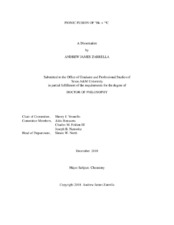| dc.contributor.advisor | Yennello, Sherry J | |
| dc.creator | Zarrella, Andrew James | |
| dc.date.accessioned | 2019-01-23T16:11:32Z | |
| dc.date.available | 2019-01-23T16:11:32Z | |
| dc.date.created | 2018-12 | |
| dc.date.issued | 2018-10-09 | |
| dc.date.submitted | December 2018 | |
| dc.identifier.uri | https://hdl.handle.net/1969.1/174318 | |
| dc.description.abstract | Pionic fusion is the process by which two nuclei collide, undergo complete fusion, and then de-excite solely by the emission of a pion. Previously measured pionic fusion cross sections are inconsistent with known mechanisms for pion production and suggest unknown collective processes might dominate production at low energies in heavy ion collisions. In this work, an experiment was developed to make the first coincident measurement of pionic fusion for a charged pion channel of a reaction for which there are no previous measurements.
The pionic fusion reaction ⁴He (55 MeV/u) + ¹²C → ¹⁶N + π⁺ was studied at the Texas A&M University Cyclotron Institute. The ¹⁶N fusion residues were detected using a dE-E silicon telescope at the focal plane of the MARS spectrometer and the newly designed ParTI phoswich detector array was used to detect the charged pions. Fast-sampling digitizers recorded the waveform responses of the phoswiches which were used to identify the pions through fast vs. slow (dEE) pulse shape discrimination and through the characteristic decay of the muon daughters of the implanted pions.
An energy calibration method for light charged particles including charged pions is developed for the ParTI phoswich detectors and the geometrical and particle identification efficiencies of the array are explored. The "muon decay trigger" which was implemented in the firmware of the onboard FPGA in the digitizers is discussed and its ability to increase the pion event selectivity is characterized. A detailed characterization of the transmission efficiency and particle identification capabilities at the focal plane of MARS is also given.
Cross sections are reported for all species detected at the focal plane of MARS and upper limits for the cross section of pionic fusion based on the measurement of ¹⁶N in MARS and charged pions in the ParTI array are reported. | en |
| dc.format.mimetype | application/pdf | |
| dc.language.iso | en | |
| dc.subject | Pionic Fusion | en |
| dc.subject | Pion Detection | en |
| dc.subject | Phoswich Detector Array | en |
| dc.title | Pionic Fusion of ⁴He + ¹²C | en |
| dc.type | Thesis | en |
| thesis.degree.department | Chemistry | en |
| thesis.degree.discipline | Chemistry | en |
| thesis.degree.grantor | Texas A & M University | en |
| thesis.degree.name | Doctor of Philosophy | en |
| thesis.degree.level | Doctoral | en |
| dc.contributor.committeeMember | Bonasera, Aldo | |
| dc.contributor.committeeMember | Folden, Charles M | |
| dc.contributor.committeeMember | Natowitz, Joseph B | |
| dc.type.material | text | en |
| dc.date.updated | 2019-01-23T16:11:33Z | |
| local.etdauthor.orcid | 0000-0003-1279-1164 | |


